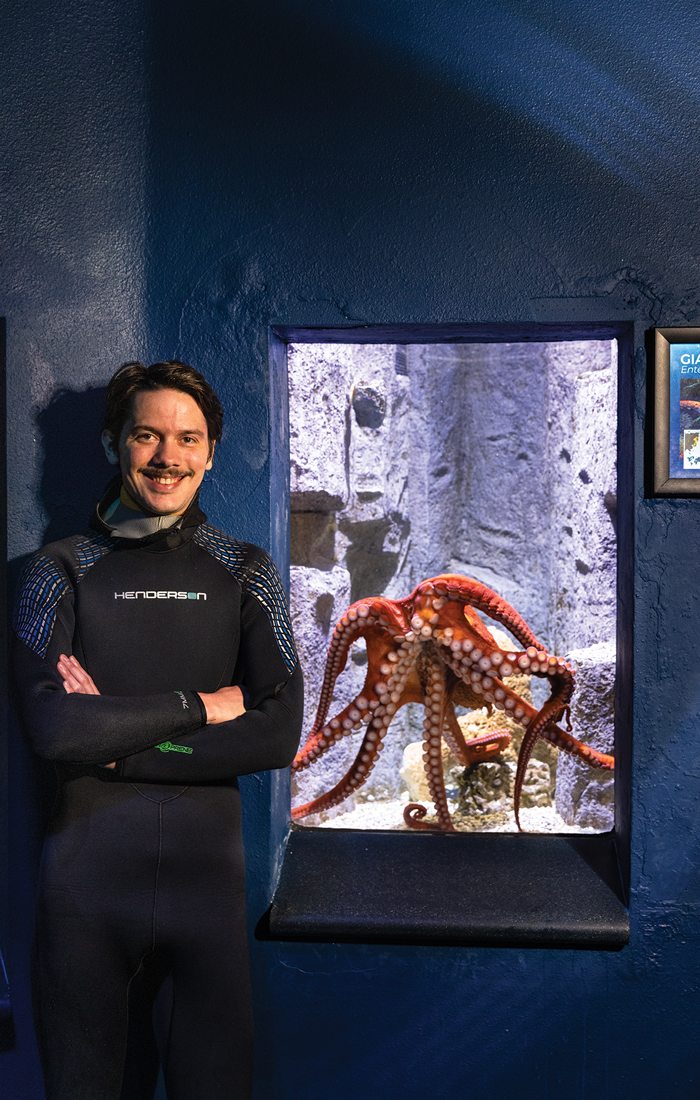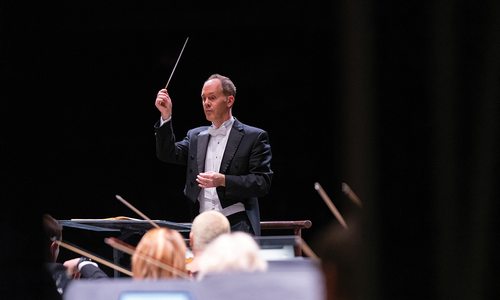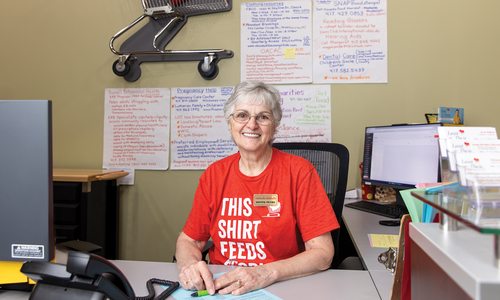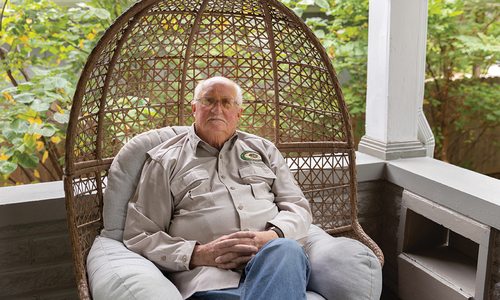People
All About Wonders of Wildlife's Octavia the Octopus and Keeper Jared Belt
Jared Belt’s job as the octopus keeper at Wonders of Wildlife in Springfield is anything but ordinary. It’s a blend of science, creativity and a whole lot of heart.
by Jennifer Swenson
Nov 2024
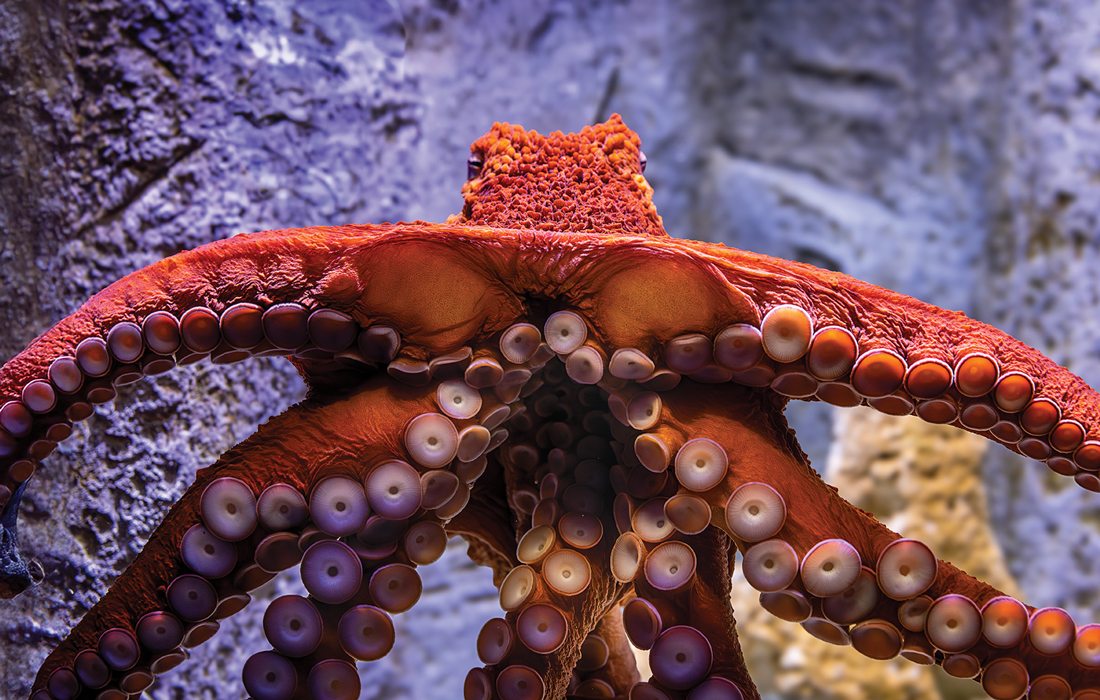
Jared Belt has the coolest job you’ve never heard of. As an aquarist at Wonders of Wildlife National Museum & Aquarium, Belt cares for a diverse array of marine life, but one of the most fascinating creatures under his watch is Octavia, the aquarium’s giant Pacific octopus. At just one year old, Octavia displays the intelligence and individuality that make giant Pacific octopuses such captivating animals for marine enthusiasts.
Belt’s care of Octavia covers all the essentials. He provides her with a high-quality protein-based diet; he checks her weight weekly; he ensures her tank is well-maintained. Yet his work goes far beyond routine tasks, demanding ingenuity and a surprising sense of camaraderie with the giant Pacific octopus.
Octavia’s tank is her home, her playground and her puzzle board. She is always testing her environment. “When she is bored, she will push over rocks in the tank,” Belt says. To keep the octopus mentally stimulated, Belt designs enrichment activities and puzzles. Activities range from hiding food around the tank to more complex tasks that require Octavia to flex her problem-solving skills. For instance, Belt will place the octopus’s food in a covered jar and flip it upside down so that she has to manipulate the jar to retrieve her meal. He might put her food inside a t-shaped PVC tube, and Octavia will reach an arm inside and maneuver the food back out. Belt has created puzzles using a plastic box and rubber bands, a hamster ball and other everyday objects. Her favorite puzzle is having her food frozen in a block of ice. “I think she likes the crunchiness of the ice, because it mimics what she’d experience in the wild,” Belt says. “She will wrap her entire body around the frozen cube and eat it quickly.” To develop new ideas, Belt takes inspiration from many sources, such as aquarists at other aquariums, social media, or finds at local stores, but he adapts each activity to Octavia’s unique and slightly shy personality.
Like all giant Pacific octopuses, Octavia has her own quirks. Whereas some octopuses “are very grabby, grabbing the side of the tank or T-shirts or retractable badges,” Belt says Octavia has a shy temperament and spends a lot of time hiding behind a rock. To coax Octavia from her hiding place, Belt will do “target training” by dangling an acrylic ball from a stick in the water. “Octavia knows if she reaches up and touches the target, she will get food,” says Belt. This training also serves a practical purpose, allowing the aquarium’s veterinarian to check on Octavia’s health.
Belt acknowledges that it’s impossible to work with an animal as intelligent as an octopus and not form a bond. For Belt, that bond is evident in how Octavia responds to him. “When she first arrived at the aquarium in January, she wasn’t sure about me,” Belt says. “But one day I got in the tank to do some work, and she reached out and touched my boot. Then she crawled all the way up to my face. I was wearing a bright yellow mask, and she touched my mask, my hair, looked straight at me.” Nowadays, when Belt arrives at her tank, Octavia will look directly at him and turn bright red (a sign she is happy), and when other people are nearby, she reaches out an arm and touches his hand. Occasionally, Belt and Octavia even play catch! “I’ll push a wiffle ball down to her, and she will push it back to me,” he says.

Growing up in Jefferson City, Belt didn’t envision his career as an octopus keeper. He studied Wildlife Biology at Missouri State University, where he planned to work with freshwater species. But his passion for saltwater creatures grew when he began working at Wonders of Wildlife’s aquatic holding building. “Saltwater species have so much color and diversity,” Belt says. “It’s rewarding work. The more effort you put in, the better they look, the more they grow, the happier and healthier they are.”
Belt brings that effort as he tends to the animals in his charge, and he will continue to innovate enriching activities. One day soon, he hopes to paint with Octavia. “We take an aquarium-safe paint, put it on a canvas, and prop it against the tank,” he says. If the octopus is interested, she may slap her tentacles against the canvas, leaving marks from her suckers and creating a one-of-a-kind piece of art.
According to Belt, “A lot of people think that we just feed the fish, but there’s much more work behind the scenes. Wonders of Wildlife is a great opportunity for people to learn about saltwater species and to inspire a passion to preserve the diversity of the oceans.”











